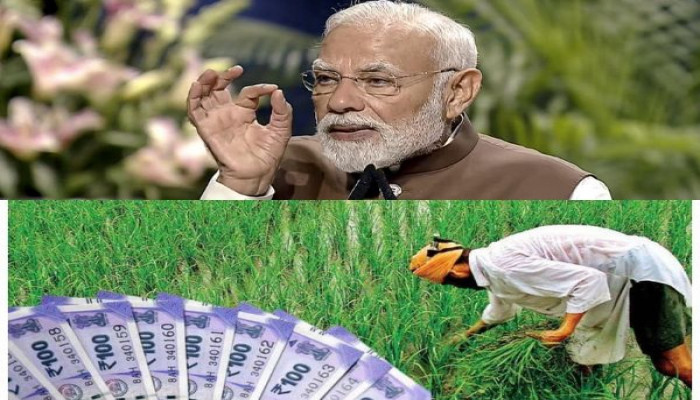PM Modi unveils ₹35,000 crore agriculture schemes at IARI
- In Reports
- 05:50 PM, Oct 11, 2025
- Myind Staff
Prime Minister Narendra Modi on Friday launched two landmark agricultural programmes worth over ₹35,000 crore at the Indian Agricultural Research Institute in New Delhi, aimed at transforming India’s rural economy and strengthening the farm sector.
Before addressing the gathering, the Prime Minister met farmers and interacted with them about their challenges and achievements.
Under the new initiatives, the government will roll out the PM Dhan Dhaanya Krishi Yojana with an investment of ₹24,000 crore and the Mission for Aatmanirbharta in Pulses with ₹11,440 crore. Alongside, Modi also inaugurated projects worth ₹5,450 crore across agriculture, fisheries, animal husbandry and food processing sectors, and laid foundation stones for new works worth ₹815 crore.
Addressing the event, Modi said, “Today is a historic day that marks the birth anniversaries of two of Maa Bharati’s illustrious sons who redefined India’s democratic fabric and rural development. Jayaprakash Narayan ji and Nanaji Deshmukh ji were the voices of rural Bharat and dedicated their lives to the empowerment of farmers and the underprivileged.”
He said the two schemes reflect the government’s commitment to building a new era of rural empowerment, self-reliance, and agricultural innovation. “The Government of India will invest over ₹35,000 crore in these initiatives, reflecting its unwavering commitment to doubling farmers’ incomes and achieving food and nutritional security for the country,” Modi said.
Modi spoke about the central role agriculture has played in India’s growth, adding that the sector had suffered neglect for decades before 2014. He said that a modern, fast-developing India needs an equally modern agricultural system — one that began taking shape only after his government came to power. “We broke away from the apathy of the past. From seed to market, we introduced comprehensive reforms in the interest of our farmers,” he said. “These reforms were not just policy changes. They were structural interventions aimed at making Indian agriculture modern, sustainable, and resilient.”
The Prime Minister pointed out that in the last eleven years, India’s farm exports have nearly doubled and foodgrain output has risen by 90 million metric tonnes. Fruit and vegetable production is up by 64 million metric tonnes, and India now ranks first in milk production and second in fish production globally. Honey and egg production, he added, have both doubled since 2014.
He listed several government interventions: six new fertiliser plants, over 25 crore Soil Health Cards, 100 lakh hectares under micro-irrigation, and ₹2 lakh crore in insurance payments under the Pradhan Mantri Fasal Bima Yojana. He said more than 10,000 Farmer-Producer Organisations have been created to help small farmers access bigger markets.
Sharing personal experiences, Modi said he regularly meets farmers, fishermen and women engaged in agriculture, and that their stories of progress show how the sector is changing from within.
He said that India’s current mindset is not satisfied with incremental change. “If we want to make India a developed nation, every sector must evolve,” he said, adding that this was the thinking behind the PM Dhan Dhaanya Krishi Yojana.
The scheme, he said, draws inspiration from the government’s Aspirational Districts Programme, which transformed once-neglected regions through focused planning and local accountability. Modi recalled how his government changed the label of “backward districts” to “aspirational districts”, and united all departments under the spirit of “Sabka Prayas”.
He said that this model led to remarkable results — from roads reaching remote villages for the first time, to full immunisation and electricity access in previously underserved schools. “These achievements came from convergence, collaboration, and competition,” he said, describing how officials and citizens worked together to deliver measurable progress.
The Prime Minister said the same principles would guide the PM Dhan Dhaanya Krishi Yojana. “The selection of these 100 districts has been carried out with thoughtful consideration and based on three key parameters,” he said. These are agricultural output per unit of land, frequency of cultivation, and access to institutional credit and investment.
“We have often heard the phrase ‘36 ka aankda’, a way of saying that two parties are completely at odds with each other. But as a government, we challenge such perceptions and reverse them,” Modi said, adding that the new plan brings together 36 different agricultural schemes under one umbrella. These include missions on natural farming, efficient irrigation, and oilseed production, along with localised livestock health drives.
He urged local officials and farmers to prepare district-level plans suited to local conditions. “Therefore, I earnestly urge the farmers and district leaders to prepare district-level action plans that are suited to the local soil and climate conditions,” he said.
Talking about the second major initiative, the Dalhan Aatmanirbharta Mission, Modi said it aims not only to boost pulse production but also to improve nutrition. He pointed out that while India is self-sufficient in grains like wheat and rice, protein deficiency remains a concern, especially among vegetarians. “Pulses remain the most significant source of plant-based protein,” he said.
“The Dalhan Atmanirbharata Mission seeks to address this challenge by boosting domestic pulse production, thereby enhancing nutritional security and self-reliance,” Modi said. The ₹11,000 crore programme aims to expand pulse cultivation by 35 lakh hectares, raise production of tur, urad, and masoor, and strengthen procurement systems. It is expected to directly benefit around two crore pulse farmers.
Reaffirming his government’s commitment to farmers, Modi said they are among the four main pillars of a developed India. He pointed out that the agricultural budget has increased nearly sixfold in the last eleven years and that this growth has especially helped small and marginal farmers.
He cited fertiliser subsidies, insurance, and new income opportunities in animal husbandry, fisheries, and beekeeping as examples of the government’s multipronged approach. He highlighted the success of honey production — which has doubled — and exports that have tripled from ₹450 crore to ₹1,500 crore. “This threefold increase in exports means more income directly reaching farmers,” Modi said.
The Prime Minister also praised women’s growing leadership in rural India, noting that they are increasingly taking up roles in farming, animal husbandry, and natural farming. He highlighted the government’s campaign to create three crore Lakhpati Didis and said, “One notable example is the rise of Namo Drone Didis across India’s villages, who are now using modern drone technology for spraying fertilisers and pesticides.”
He said that more than 17,000 clusters are now promoting natural farming, supported by 70,000 trained ‘Krishi Sakhis’ who guide farmers on eco-friendly practices. Empowering women, he said, is not just about equality — it is key to building a prosperous rural India.
Highlighting GST reforms, Modi said the government has made farm equipment and essential tools more affordable. “A tractor now costs ₹40,000 less, while the prices of drip irrigation systems, sprinklers, and harvesting tools have also reduced,” he said. Cheaper organic fertilisers and bio-pesticides, he added, are also helping farmers adopt sustainable methods.
He concluded by calling on farmers to go beyond self-sufficiency and focus on export-oriented crops. “The PM Dhan Dhaanya Krishi Yojana and Dalhan Atmanirbharata Mission will play a crucial role in this journey,” he said, congratulating farmers across the country.







Comments